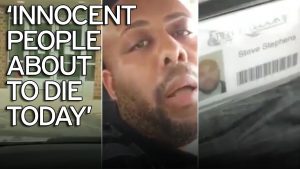Previous post

Cleveland police announced that Steve Stephens, the “Facebook Shooter,” shot himself after a police chase. Police spotted him on Tuesday morning, gave chase, and when they tried to pull him over, Stephens killed himself.

Cleveland can now exhale. However, social media and those who use it need to do some soul-searching.
Facebook launched its Facebook Live service last year, and founder Mark Zuckerberg seemed to be over the moon about its promise. Social media sites like Hootsuite were upbeat about the prospects for business.
But it didn’t take long before the dark side of Live Streaming emerged. It started with the death of Philando Castile, who was shot by police in Minnesota in July. His girlfriend streamed the event live to Facebook. Did Facebook take it down? Well, yes. For an hour. Then it reposted it with a “graphic content” warning.
Zuckerberg made a typical my-heart-goes-out statement but continued to defend Live Streaming as a way to “shine a light on fear.”
Then this happened in January. Four people in Chicago kidnapped, beat, and humiliated a mentally disabled man and Live Streamed their work on Facebook. Fortunately, they were caught and charged with various crimes, but not until the video had already been viewed and shared.
Facebook defended its video posting service, and even made an asinine claim that sometimes this sort of content is shared to “condemn violence or raise awareness.”
“We do not allow people to celebrate or glorify crimes on Facebook and have removed the original video for this reason. In many instances, though, when people share this type of content, they are doing so to condemn violence or raise awareness about it. In that case, the video would be allowed.”
And now another family is facing grief wrought by Steve Stephens, the Facebook Shooter, who shot their father and posted his shocking death on Facebook. Stephens killed 74-year-old Robert Godwin on Easter Sunday as the the elderly man was collecting aluminum cans. He videoed the shooting and uploaded it to Facebook.
As Godwin’s son explains in this interview, not only did Stephens kill his father, but he also “stripped him of his dignity” by posting it.
Facebook global operations VP Joel Osofsky claimed in this statement:
In this case, we did not receive a report about the first video, and we only received a report about the second video — containing the shooting — more than an hour and 45 minutes after it was posted. We received reports about the third video, containing the man’s live confession, only after it had ended.
Which means this: how many people viewed the horrific death of Mr. Godwin before it was reported? How many people shared it? Even worse, how many Facebook users were more thrilled at watching a shooting than were appalled at the crime? How many just said, “Dang!” and posted it on their Facebook wall before it was pulled?
Meanwhile, Mark Zuckerberg continued to prattle on about “community.”
https://youtu.be/BFstXIHPUg0
In his Facebook statement, Osofsky said, “we need to do better.” He reported that Facebook is working to improve its reviewing process, and that new technologies like artificial intelligence can help prevent resharing of videos. But all the A.I. and improved Facebook review systems will not save the soul of social media, which seems to be obsessed with the craven and has little regard for those it hurts.
new technologies like artificial intelligence can help prevent resharing of videos
Yeah, like ones posted by Chinese dissidents. Or gay Chechnyans. Or a Christian worshipping on Palm Sunday in Egypt. Or……
It’s just a technology. The problem is in the hearts of men, not with the tool. Nailed it, Kim.
1 Comment